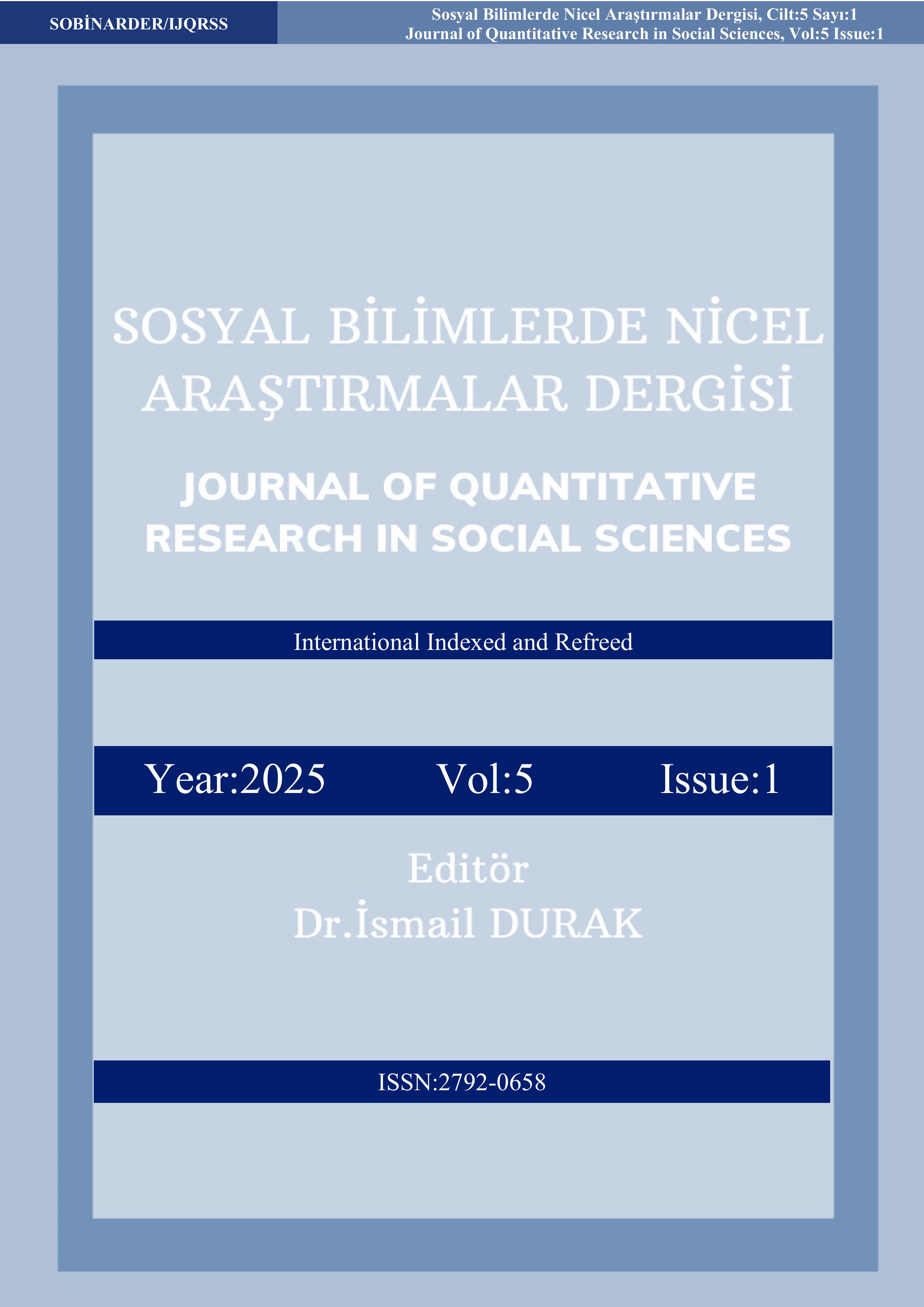Evaluation of Social Policy Scenarios Against Declining Fertility Rates Through a System Dynamics Model: The Case of Turkey
Azalan Doğurganlık Oranlarına Karşı Sosyal Politika Senaryolarının Sistem Dinamiği Modeli ile Değerlendirilmesi: Türkiye Örneği
Keywords:
Fertility Rate, Social Policy, System Dynamics, Population Policy, SimulationAbstract
In recent years, the decline in fertility rates in Turkey has emerged not only as a demographic phenomenon but also as a structural transformation process that threatens the sustainability of social and economic systems. This study analyzes the underlying causes of the fertility decline in Turkey and evaluates the potential impacts of social policy scenarios developed in response to this issue through a system dynamics modeling approach. First, historical fertility trends in Turkey are examined; subsequently, the demographic and socio-economic consequences of the current fertility structure are revealed. Then, the adequacy of the current social policy instruments offered by the government to address this decline is discussed. In the modeling phase, three main scenarios are defined: continuation of current policies, increase in financial incentives and development of structural supports such as childcare services and parental leave. According to simulation results covering the years 2024–2044, financial incentives alone are not sufficient, while structural supports generate more lasting and positive effects on fertility in the long term. The findings indicate that fertility policies cannot be limited to economic incentives alone and emphasize the need for comprehensive and multidimensional social policy approaches. In this regard, the study provides a significant contribution to policymakers in developing data-driven and long-term strategies.
References
Aile ve Sosyal Hizmetler Bakanlığı. (2013). Türkiye’de doğurganlık oranlarının düşmesi, potansiyel etkiler ve sosyal politika önerileri. Ankara: Aile ve Sosyal Politikalar Bakanlığı, Araştırma ve Sosyal Politikalar Genel Müdürlüğü.
https://www.aile.tr/uploads/athgm/uploads/pages/arastirmalar/tu-rkiye-de-dog-urganlik-oranlari.pdf
Akkaya, M. A. (2025). Türkiye’nin azalan doğurganlık oranı ve Nüfus Politikaları Kurulu’nun değerlendirilmesi. Sosyal, Beşeri ve İdari Bilimler Dergisi, 8(4), 286–304. Doi:10.26677/TR1010.2025.1537
Aydın, O., Bostan, P. A., & Özgür, E. M. (2018). Mekânsal veri analizi teknikleriyle Türkiye’de toplam doğurganlık hızının dağılımı ve modellenmesi. Coğrafya Dergisi, (37), 27–45. Doi:10.26650/JGEOG434650
Aysan, M. F. (2020). Geleceğin Türkiyesinde sosyal politikalar. İstanbul: İlke Yayınları.
Bakkal, S. (2025). Türkiye’de yüksek enflasyon nedeniyle doğum oranlarının azalması ve sonuçları. Yönetim Bilimleri Dergisi, 23(56), 814–840. Doi:10.35408/comuybd.1559881
Benli, M., & Çağlar, A. (2023). Long-term macroeconomic determinants of fertility rates in Türkiye. Bildiri sunulmuştur: 10th International Congress on Humanities and Social Sciences in a Changing World, İzmir, Türkiye.
Bostan, H., & Doğan, Ö. S. (2019). Türkiye’nin demografik dönüşümü ve nüfus projeksiyonlarına göre fırsatlar. Doğu Coğrafya Dergisi, 24(41), 61–90. Doi:10.17295/ataunidcd.535018
Coşan, B. (2022). Türkiye’de doğurganlığın değişimi: Sosyal politika açısından riskler ve fırsatlar. Sosyal Politika Çalışmaları Dergisi, 22(56), 597–617. Doi:10.21560/spcd.vi.963155
Çakıcı, K., & Atay, E. (2024). Türkiye’de yaş dostu belediyecilik uygulamaları: Yaş dostu kentler ve topluluklar küresel ağı bağlamında bir inceleme. Sosyal Siyaset Konferansları Dergisi, (87), 158–178. Doi:10.26650/jspc.2024.87.1522632
D’Addio, A. C., & D’Ercole, M. M. (2005). Trends and determinants of fertility rates:The role of policies. Paris: OECD.
Forrester, J. W. (1997). Industrial dynamics. Journal of the Operational Research Society, 48(10), 1037–1041. Doi:10.1057/palgrave.jors.2600946
Gauthier, A. H. (2007). The impact of family policies on fertility in industrialized countries: A review of the literature. Population Research and Policy Review, 26, 323–346. Doi:10.1007/s11113-007-9033-x
Güvendi, M. A. (2018). Karşılaştırmalı bir perspektiften Türkiye’de aile politikaları. İlke Politika Notu, 8, 1–26.
Karakaya, E. (2016). Socio-economic determinants on fertility rate at aggregate level in Turkey. Toplum ve Demokrasi, 10, 57–70.
Kesen, H. (2023). Çalışan anneleri destekleyen sosyal politika uygulamaları ve Türkiye’de uygulanabilirliği. Bildiri sunulmuştur: VIII. World Women Studies Conference, 7–8 Mart 2025, Antalya, Türkiye.
Keskin, F., & Koç, İ. (2023). Cumhuriyetin 100. yılında Türkiye’nin demografik yapısı ve öncelik alanları. Nüfusbilim Dergisi, 45, 5–27.
Kohler, H. P., Billari, F. C., & Ortega, J. A. (2006). Low fertility in Europe: Causes, implications and policy options. In The baby bust: Who will do the work (ss. 48–109).
Miladinov, G. (2021). Impact of unemployment by sex and marriage rate on fertility decline: Estimates for Turkey and Greece using CCR model. Population and Economics, 5(3), 76–89. Doi: 10.3897/popecon.5.e69189
Özdoğan, F., & Develi, A. (2020). İktisat politikaları çerçevesinde tek parti dönemi hükümet programlarında sosyal politika hedefleri (1923–1939). Uluslararası Anadolu Sosyal Bilimler Dergisi, 4(3), 4–36.
Reibstein, L. (2017). The impact of public policy on fertility rates in OECD countries: A comparative study (Yayımlanmamış yüksek lisans tezi). Lund University, School of Economics and Management.
Richardson, G. P. (2011). Reflections on the foundations of system dynamics. System Dynamics Review, 27(3), 219–243. Doi: 10.1002/sdr.462
Sleebos, J. (2003). Low fertility rates in OECD countries: Facts and policy responses (OECD Social, Employment and Migration Working Papers No. 15). Paris: OECD Publishing.
Söyler, H. (2006). Sistem dinamiği yaklaşımı ile Malatya ilinin sosyo-ekonomik gelişim projeksiyonu (Yayımlanmamış doktora tezi). İstanbul Üniversitesi, Sosyal Bilimler Enstitüsü, Sayısal Yöntemler Anabilim Dalı.
Şenaras, A. E. (2017). Su kaynakları yönetimi için bir öneri: sistem dinamiği. İşletme Araştırmaları Dergisi, 9(3), 668–692. Doi: 10.20491/isarder.2017.317
Şenaras, A. E., & İnanç, Ş. (2022). Sistem dinamiği modeli ile elektrik enerjisi piyasasının incelenmesi. İşletme Araştırmaları Dergisi, 14(4), 2796–2814. Doi: 10.20491/isarder.2022.1534
Sterman, J. (2002). System dynamics: Systems thinking and modeling for a complex world [Çevrim içi kitap/rapor versiyonu].
Thévenon, O. (2011). Family policies in OECD countries: A comparative analysis. Population and Development Review, 37(1), 57–87. Doi: 10.1111/j.1728-4457.2011.00390.x
Tursun, A., & Tursun, M. (2025). Türkiye’de sistem dinamiği yaklaşımıyla yazılan lisansüstü tezlerin bibliyometrik analizi. Fiscaoeconomia, 9(1), 138–151. Doi: 10.25295/fsecon.1478744
Tursun, M., & Aksu, İ. (2022). Sistem dinamiği yaklaşımı ve sosyal bilimlerde kullanımı. Pamukkale Üniversitesi Sosyal Bilimler Enstitüsü Dergisi, (51), 71–86. Doi: 10.30794/pausbed.1107306
Türkiye İstatistik Kurumu (TÜİK). (2023). Doğum istatistikleri, 2023.
Yavuz, S. (2008). Fertility decline in Turkey from the 1980s onwards: Patterns by main language groups. Rostock: Max Planck Institute for Demographic Research.
Yılmaz, M. (2025). Toplumsal cinsiyet üzerine yapılan çalışmalar ve sosyal politika uygulamaları: Samsun ili örneği. Biga İktisadi ve İdari Bilimler Fakültesi Dergisi, 6(1), 24–47. Doi: 10.70754/biibfd.1630327
Downloads
Published
How to Cite
Issue
Section
License
Copyright (c) 2025 Journal of Quantitative Research in Social Sciences

This work is licensed under a Creative Commons Attribution-NonCommercial 4.0 International License.
Telif hakkı hakkında










